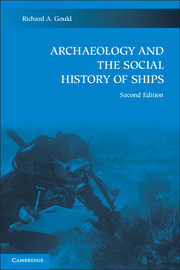Book contents
- Frontmatter
- Contents
- List of figures
- List of tables
- Acknowledgments
- Introduction: Toward a higher standard
- 1 Interpreting the underwater archaeological record
- 2 Underwater archaeology: The state of the art
- 3 Ships and shipwrecks: Basic mechanics
- 4 The archaeology of small watercraft
- 5 The earliest ships
- 6 Shipwrecks and our understanding of ancient trade
- 7 Sailing ships of the Middle Ages
- 8 Ships of the great age of sail
- 9 From sail to steam in maritime commerce
- 10 New technologies and naval warfare
- 11 The archaeology of maritime infrastructure
- 12 The future of shipwreck archaeology
- References cited
- General index
- Ship and site index
2 - Underwater archaeology: The state of the art
Published online by Cambridge University Press: 05 June 2012
- Frontmatter
- Contents
- List of figures
- List of tables
- Acknowledgments
- Introduction: Toward a higher standard
- 1 Interpreting the underwater archaeological record
- 2 Underwater archaeology: The state of the art
- 3 Ships and shipwrecks: Basic mechanics
- 4 The archaeology of small watercraft
- 5 The earliest ships
- 6 Shipwrecks and our understanding of ancient trade
- 7 Sailing ships of the Middle Ages
- 8 Ships of the great age of sail
- 9 From sail to steam in maritime commerce
- 10 New technologies and naval warfare
- 11 The archaeology of maritime infrastructure
- 12 The future of shipwreck archaeology
- References cited
- General index
- Ship and site index
Summary
Nearly all archaeological recording techniques represent trade-offs between the desire for precision and the practical limitations imposed by funding, time, logistics, and personnel. Underwater archaeology has available to it a wide array of tools, ranging from the simple trowel to sophisticated remote-sensing devices like the magnetometer, side-scan sonar, and subbottom profiler, none of which were ever originally intended or designed specifically for archaeological use. As we characterize the current state of the art in underwater archaeology, it is important to keep in mind the minimalist principle of using the simplest tool or technique available for the task required. This does not mean taking shortcuts with controls needed to obtain convincing results, but it does warn against relying on complex and often untried or experimental technologies when simpler or more reliable techniques are available to accomplish the same task. The reason for such caution is the destructiveness of archaeological excavation. Careless or inadequately controlled excavation will result in the permanent disruption of archaeological associations and the consequent loss of essential information about the site and how it formed. The choice of archaeological techniques and controls employed at a particular site where excavation is deemed necessary is perhaps the most critical decision the archaeologist faces.
An example of what can happen in the absence of archaeological techniques and controls is the recovery of the USS Cairo, a Federal ironclad river gunboat that sank in 1862 near Vicksburg, Mississippi, after falling victim to a Confederate explosive mine during the Civil War.
- Type
- Chapter
- Information
- Archaeology and the Social History of Ships , pp. 25 - 62Publisher: Cambridge University PressPrint publication year: 2011



